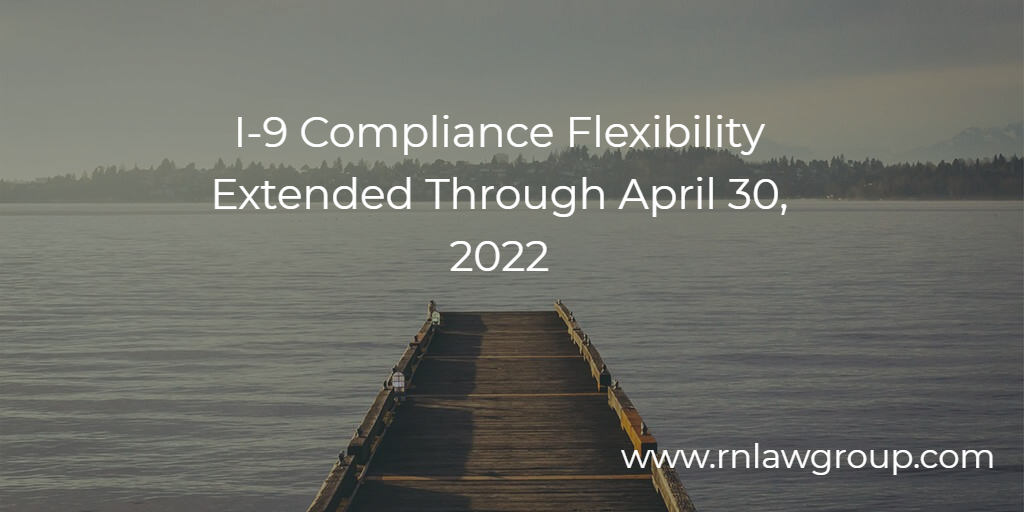
I-9 Compliance Flexibility Extended Through April 30, 2022
U.S. Immigration and Customs Enforcement (ICE) announced that it would once again provide relief to employers operating remotely due to COVID-19 precautions by extending the Form I-9 flexibilities until April 30, 2022.
The current extension will continue to apply to employees hired on or after April 1, 2021 and who work exclusively in a remote setting due to COVID-19-related precautions. Those employees are temporarily exempt from the physical in-person inspection requirements associated with Form I-9 until they undertake non-remote employment on a regular, consistent, or predictable basis, or the extension of the flexibilities related to such requirements is terminated, whichever is earlier. Prior to April 1, 2021, the physical presence flexibilities did not apply if there were any employees physically present on-site.
How It Works
Employers who are operating remotely due to COVID-19 will not be required to review the employee’s identity and employment authorization documents in the employee’s physical presence. However, employers must still inspect the Section 2 documents remotely over video link, fax, email, etc. and obtain, inspect, and retain copies of the documents, within three business days for purposes of completing Section 2. If reverification is required, Section 3 must be completed before the employee’s work authorization expires.
It is important to remember that the I-9 flexibilities allow employers operating remotely the option to only postpone the physical presence inspection requirements. This means that after employers resume normal operations at their business, all employees who were on-boarded or re-verified using the remote verification option, must report to their employer within three business days for in-person verification of identity and employment eligibility documentation for Form I-9.
The following recommendations have been provided by DHS regarding how to notate Form I-9 when remotely inspecting employment authorization and identity documents, and how to perform the required physical inspection once normal business operations resume:
Completing Section 2 when inspecting documents remotely
- Employers should enter “Remote inspection completed on XX/XX/XXXX” in the Section 2 Additional Information box.
Performing physical in-person inspection once normal operations resume
- If the person who performed the remote inspection also performs the physical inspection, the individual should enter “COVID-19” as the reason for the physical inspection delay in the Section 2 Additional Information box on the Form I-9. Once the documents have been physically inspected, the employer should add in the Section 2 Additional Information box “documents physically examined” with the date of physical inspection along with their initials.
- If the physical inspection is performed by an individual who did not perform the remote inspection, the person who performs the physical inspection should indicate the date they examined the documents as well as their full name and title in the Section 2 Additional Information box. Note that employers in this situation also have the option to complete a new Section 2 of the form I-9 and attach it to the previous form I-9 used for remote inspection.
Notating remote and physical inspection for reverification
- Employers should make required notations for remote and subsequent physical inspections of reverifications in the Additional Information box in Section 2 as described above.
For examples, see: https://www.uscis.gov/i-9-central/form-i-9-examples-related-to-temporary-covid-19-policies
Employers who have been performing I-9 remote inspections may be burdened by the physical presence inspection requirement once normal business operations resume. This is especially true if DHS does not allow any leniency on the 3-day requirement for physical presence inspection once the flexibility ends.
Authorized Representative Option:
One option employers have moving forward is to designate or contract with someone such as a personnel officer, foreman, agent, or anyone else acting on the company’s behalf, including a notary public, to complete Section 2 or 3 in-person. Note though that anyone else who completes Form I-9 on your behalf must carry out full Form I-9 responsibilities. Further, the company is liable for any violations in connection with the form or the verification process, including any violations of the employer sanctions laws committed by the person designated to act on your behalf. Therefore, if you decide to go this route, it is important to have detailed instructions for both the employee and authorized representative to ensure full I-9 compliance.
Employers inspecting documents remotely pursuant to the Form I-9 COVID-19 flexibilities or who are considering the authorized representative option should seek advice from an experienced attorney to ensure I-9 compliance.
Will the I-9 Remote Option Ever be Permanent?
The COVID-19 pandemic has led many employers to allow work from home options for its employees. With some companies either turning away from the in-office work requirement altogether or moving to a hybrid option, will DHS catch-up and allow for permanent I-9 remote inspection? In October 2021, DHS suggested that they are considering making virtual verification a permanent option by requesting input from the public about its experience with the COVID-19 Form I-9 flexibilities. We encourage employers to submit their comments and suggestions. All comments must be submitted by December 27, 2021. Please visit the following link for instructions: https://www.govinfo.gov/content/pkg/FR-2021-10-26/pdf/2021-23260.pdf.
By: Krystal Alanis
Krystal Alanis is a Partner at Reddy Neumann Brown PC, Houston’s largest immigration law firm focused solely on U.S. employment-based immigration. She acts as the Managing Attorney for the firm’s PERM Labor Certification Department, where she oversees all EB-2 and EB-3 employment-based green card matters. She also guides employers and individuals through the I-140 and Adjustment of Status process, assists clients with non-immigrant visa petitions (e.g. H-1B, TN, L-1, etc.), and advises her clients on I-9 compliance issues.

